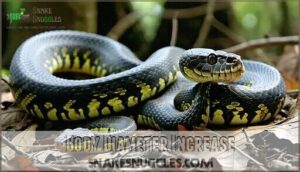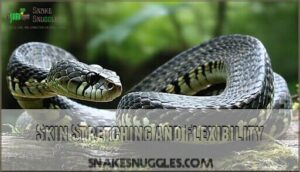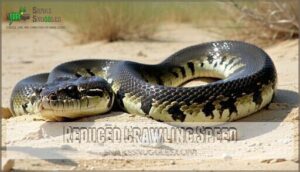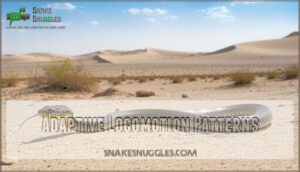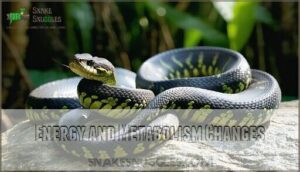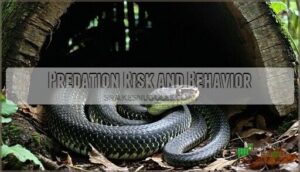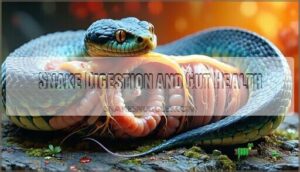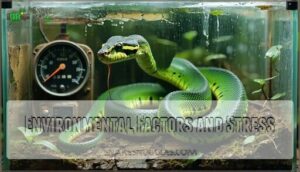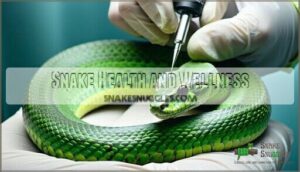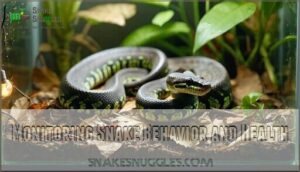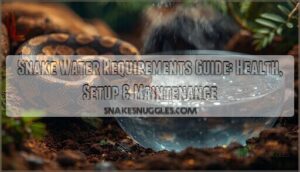This site is supported by our readers. We may earn a commission, at no cost to you, if you purchase through links.
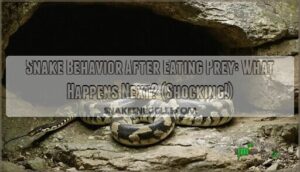
Snake behavior after eating prey includes markedly reduced movement speed, often crawling at half their normal pace, since the bulky meal throws off their balance and center of gravity.
You’ll notice they become less active, preferring to remain motionless in secure hiding spots where they’re protected from predators, due to their increased vulnerability stemming from limited mobility and the visible prey bulge making them conspicuous targets.
Most snakes won’t eat again for weeks or months, depending on meal size, which reveals fascinating survival strategies that guarantee successful digestion.
Table Of Contents
- Key Takeaways
- Snake Feeding Behavior
- Physical Changes After Eating
- Locomotion Changes Post-Feeding
- Energy and Metabolism Changes
- Predation Risk and Behavior
- Snake Digestion and Gut Health
- Environmental Factors and Stress
- Snake Health and Wellness
- Post-Feeding Care and Handling
- Monitoring Snake Behavior and Health
- Frequently Asked Questions (FAQs)
- How do snakes act after eating?
- How do you know if a snake is stressed out?
- Do snakes get defensive after eating?
- How long should I not handle my snake after eating?
- Do snakes sleep differently after eating meals?
- Can snakes drink water while digesting food?
- How do snakes breathe with large prey?
- Do pregnant snakes behave differently when feeding?
- Can multiple snakes share feeding spaces safely?
- Conclusion
Key Takeaways
- You’ll notice your snake slows down dramatically after eating – crawling speed drops by up to 70% due to the bulky meal throwing off their balance and making normal movement patterns difficult.
- Your snake becomes highly vulnerable and will seek secure hiding spots – the visible prey bulge makes them conspicuous targets for predators, so they’ll remain motionless in protected areas until digestion progresses.
- Don’t handle your snake for at least 48-72 hours after feeding – disturbing them during this critical period can cause dangerous regurgitation that leads to serious health complications.
- Your snake’s metabolism skyrockets while activity plummets – their body prioritizes digestion over everything else, with metabolic rates jumping up to 44 times normal levels while they enter extended periods of inactivity.
Snake Feeding Behavior
When you watch your snake consume prey, you’re witnessing the beginning of a complex biological transformation that affects every aspect of its physiology and behavior.
Your snake’s body becomes a living laboratory where every system transforms to process its meal.
Your pet snake’s body will undergo dramatic changes over the next several days, from altered movement patterns to heightened metabolic demands that reshape how it interacts with its environment.
Prey Selection and Ingestion
Your snake’s prey-selection process involves careful consideration of several factors that directly impact successful consumption and digestion.
Understanding these elements helps guarantee proper nutrition and feeding practices.
Key prey selection factors include:
- Prey size – Should match 10% of your snake’s body weight and approximate its widest diameter
- Prey type – Species-specific dietary needs determine appropriate options like rodents, birds, or reptiles
- Frozen prey – Safer than live options, eliminating injury risks during feeding
- Gut-loading – Enhances nutritional value by feeding prey calcium and vitamins beforehand
Snake feeding behavior demonstrates remarkable adaptability, with different snake prey types requiring specific feeding practices to optimize the snake digestion process and meet individual dietary needs.
Feeding Frequency and Schedules
When determining your snake’s feeding frequency, age becomes the primary factor.
Juvenile schedules require meals every 5-7 days due to rapid growth demands, while adult schedules extend to monthly intervals as metabolism slows.
| Age Group | Weight Range | Feeding Frequency |
|---|---|---|
| Hatchlings | Under 300g | Every 5 days |
| Juveniles | Under 750g | Every 7 days |
| Adults | 800g+ | Every 10-14 days |
| Large Adults | 1400g+ | Every 7-10 days |
Seasonal changes affect snake metabolism substantially, with cooler months reducing appetite and digestion speed.
Prey influence also matters—larger meals extend intervals between feedings as the digestion process demands more energy resources.
It’s vital to choose prey size appropriate for the snake’s head size to prevent regurgitation and stress.
Prey Size and Type Considerations
Your snake’s prey choice directly impacts the digestion process and snake behavior afterward.
Ideal Size should match your snake’s body width, roughly 10% of its weight, ensuring proper snake digestion without strain.
Consider these key factors:
- Prey Variety – Different species require specific prey types for adequate Nutritional Value
- Frozen vs Live – Frozen options eliminate injury risks while maintaining digestive benefits
- Species Specifics – Research your snake’s natural diet for ideal prey type selection
Physical Changes After Eating
When you watch a snake swallow prey that’s seemingly too large for its body, you’re witnessing one of nature’s most remarkable physical transformations.
The ingested meal creates a dramatic bulge that can double or triple the snake’s diameter at the feeding site, stretching the skin considerably and temporarily altering the animal’s entire body proportions, which is a remarkable physical change, involving a dramatic transformation.
Body Diameter Increase
After a big meal, you’ll notice your pet’s midsection balloon out—sometimes doubling or tripling in width.
This dramatic body diameter increase isn’t just for show; it’s a direct result of Meal Size and the digestive process.
The bulge affects Flexibility Impact, leads to Locomotion Changes, and even increases Predation Vulnerability due to visible Internal Organ Changes.
| Before Meal | After Meal |
|---|---|
| Slim profile | Noticeable bulge |
| Flexible | Stiff, awkward |
| Quick crawl | Slower movement |
Skin Stretching and Flexibility
You’ll witness remarkable integumentary changes as your snake’s skin stretches dramatically to accommodate its meal.
The scales undergo significant girth expansion, with some becoming temporarily dented or even cracked from the extreme stretching.
This scale adaptation creates flexibility limits that weren’t present before feeding, and movement restriction occurs because the stretched skin can’t contract and expand as efficiently during locomotion, fundamentally altering your snake’s physical capabilities.
Center of Gravity Shift
Picture a hefty backpack—after a meal, your snake’s center of gravity shifts forward, forcing real postural control and movement adaptation.
This balance challenge leads to sluggish movement and reduced mobility.
You’ll notice:
- Locomotion efficiency drops, with more muscular compensation needed
- Postfeeding behavior includes cautious, slow crawling
- Locomotor impairment means your snake avoids risky climbs, prioritizing stability over speed and buoyancy changes
Ambush predators experience a higher metabolic scope after feeding.
Locomotion Changes Post-Feeding
After a snake finishes a large meal, you’ll notice its movement slows down dramatically, with crawling speed dropping by as much as 70% and flexibility sharply reduced by the bulge of prey.
From lightning-fast predator to sluggish, vulnerable creature—your snake’s dramatic transformation after a big meal.
To compensate for this awkward new shape, snakes often switch to alternative locomotion patterns, such as rectilinear progression, which lets them keep moving forward even when their usual slithering style just won’t cut it, allowing for continued movement despite the challenges posed by the bulge of prey.
Reduced Crawling Speed
After consuming prey, your snake’s maximum crawling speed plummets by up to 70%, transforming it from a sleek predator into a sluggish creature.
This dramatic Post-Meal Speed reduction stems from the substantial bulge disrupting normal serpentine undulations.
The increased Locomotion Cost forces your snake into energy-saving mode, prioritizing snake digestion over swift movement.
This postfeeding behavior creates significant Vulnerability Increase, making Adaptive Movement patterns essential for survival during this locomotor impairment phase.
Limited Flexibility and Mobility
After consuming prey, your snake’s expanded girth severely restricts the smooth, wavelike movements essential for normal locomotion.
The bulge creates mechanical constraints that limit flexibility, making typical serpentine undulations less efficient and dramatically increasing energy cost.
This reduced mobility persists for days, with postfeeding behavior characterized by sluggish movements and heightened predation vulnerability due to locomotor constraints affecting the snake’s adaptive capability.
Adaptive Locomotion Patterns
Despite reduced mobility, your snake won’t stay completely motionless after eating.
Post-meal gaits shift dramatically as serpentine movement becomes inefficient due to the bulky prey.
Rectilinear progression offers a rectilinear advantage, using belly scales for forward motion without body undulation.
This evolutionary adaptation maintains energetic efficiency when postfeeding behavior demands movement, demonstrating how locomotion patterns adapt to prey size impact challenges.
Energy and Metabolism Changes
After a snake eats, you’ll notice its metabolism kicks into overdrive, with energy demands skyrocketing as digestion takes center stage.
This process forces the snake to balance its limited resources, often leading to a period of remarkable inactivity—think of it as the reptile version of a post-Thanksgiving nap, but with much higher stakes, where inactivity and digestion are key.
Increased Metabolic Rate
Following your snake’s meal, its metabolic rate skyrockets dramatically, creating an internal energy storm.
The digestion process triggers specific dynamic action (SDA), where oxygen consumption increases four to six-fold, sustained by pronounced tachycardia effects and unidentified humoral factors.
Key postprandial metabolism changes include:
- SDA Magnitude – Metabolic rate jumps up to 44 times resting levels
- Oxygen Consumption – Sustained increases support intensive digestion processes
- Postprandial Rise – Energy expenditure peaks during active snake physiology transformation
Competing Energy Demands
When you feed your snake, it’s like forcing its body to choose between two demanding jobs.
Digestion requires up to 50% of the meal’s energy, while movement competes for the same resources.
This creates a fascinating energy tug-of-war.
| Energy Demand | During Fasting | Post-Feeding |
|---|---|---|
| Metabolic Rate | 1x baseline | Up to 45x baseline |
| Organ Size | Normal | 50% larger |
| Movement Cost | Standard | 30-40% higher |
| Energy Priority | Movement/survival | Digestive process |
| Activity Level | Normal hunting | Reduced mobility |
Your snake’s body can’t efficiently run both systems at full capacity simultaneously, so metabolic prioritization kicks in, favoring digestion over movement.
This prioritization is crucial for the snake’s survival, as it allows the snake to allocate its energy resources effectively, ensuring that the digestive process is completed efficiently.
Digestion and Movement Prioritization
When your snake finishes eating, its body basically puts all available energy toward digestion priority while dramatically reducing movement cost.
Energy allocation shifts completely, creating postprandial inactivity as cardiovascular adjustments support the intense digestion process.
Movement becomes secondary priority.
Here’s how energy gets redistributed after feeding:
- Metabolic rate increases 44 times – The digestion process demands massive energy expenditure, leaving little for locomotion patterns
- Blood flow redirects to digestive organs – Cardiovascular adjustments prioritize gut motility over muscle function
- Movement costs rise 30-40% – Postfeeding movement becomes energetically expensive due to physical constraints
- Voluntary activity decreases – Your snake naturally reduces movement to conserve energy for digestion
- Rest becomes essential – Extended inactivity allows ideal energy allocation for breaking down prey
Reorganizing the structure for improved readability results in a clearer understanding of the energy redistribution process in snakes after feeding.
Predation Risk and Behavior
When you’ve just watched your snake consume prey, you’ll notice it becomes substantially more vulnerable to threats due to reduced mobility and conspicuous bulging.
Your snake instinctively knows this danger and will immediately seek secure hiding spots, remaining motionless until digestion progresses enough to restore normal defensive capabilities.
Increased Vulnerability to Predators
When you’re dealing with a recently fed snake, you’re witnessing a creature in its most vulnerable state.
That visible bulge drastically reduces escape speed by over 25%, creating a critical vulnerability window.
Predation rates spike during this period because the distended body makes snakes easier targets, forcing them to prioritize survival over hunting, as their usual predator avoidance strategies become compromised, leading to complete foraging cessation.
Behavioral Compensation and Hiding
When you’re more vulnerable, smart moves matter most.
Your snake instinctively seeks secure hiding spots immediately after eating, using crypsis and shelter seeking as primary defenses.
This postfeeding immobility isn’t laziness—it’s survival strategy.
By embracing refuge use and snake resting behavior, they minimize predator encounters.
Watch for basking behavior in safe zones, where your pet prioritizes predator avoidance over movement.
Reduced Foraging and Activity
Post-meal inactivity becomes your snake’s dominant behavior as energy conservation takes priority over hunting activities.
Your serpent enters a prolonged resting phase, dedicating metabolic resources entirely to digestion rather than movement or prey detection.
Here’s what drives this reduced activity pattern:
- Energetic costs – Movement demands increase by 30-40% while digesting, creating unsustainable energy drains
- Digestion prioritization – Your snake’s body redirects all available resources toward breaking down prey efficiently
- Postfeeding immobility – Physical limitations from the food bulge make normal hunting behaviors nearly impossible
This digestion timeline varies by species and prey size, but expect several days of minimal activity.
Snake Digestion and Gut Health
After your snake consumes its prey, the digestive system undergoes remarkable transformations that directly impact your pet’s overall health and behavior.
Understanding these internal processes helps you recognize normal digestion patterns, optimize feeding schedules, and identify potential health concerns before they become serious problems, which is crucial for maintaining your pet’s overall health.
Digestive System Function and Health
After consuming prey, your snake’s digestive system undergoes remarkable transformations that support ideal nutrient absorption and digestive health.
The gut microbiome activates specialized digestive enzymes, while intestinal motility increases dramatically to process the meal efficiently.
Enhanced enzyme production breaks down proteins and fats, maximizing nutrient absorption through expanded intestinal walls, which guarantees proper waste elimination once digestion completes, ensuring the overall digestive health.
Gut Loading and Nutritional Value
When you’re feeding your snake, the prey’s gut content matters more than you’d think.
Gutloading enhances nutritional value by enriching prey with calcium sources, vitamin supplementation, and mineral enrichment 24-72 hours before feeding.
This practice boosts D3 synthesis and improves digestion efficiency, directly impacting your snake’s health and growth rates substantially.
Ideal nutrition often involves species-specific dietary needs.
Defecation Frequency and Health
Your snake’s digestive system follows a predictable pattern that directly links to defecation frequency. Unlike mammals, snakes typically defecate only after fully digesting their prey, which means fecal matter appears days or weeks after feeding depending on meal size and environmental conditions.
Here’s what healthy snake defecation tells you:
- Normal frequency matches feeding schedule – One bowel movement per meal indicates proper digestive health and appropriate feeding intervals
- Fecal consistency reveals hydration levels – Well-formed waste with visible urates appearance signals adequate moisture and healthy kidney function
- Frequency changes signal digestive issues – Sudden increases or decreases in defecation patterns often indicate stress, illness, or environmental problems
- Clear urates indicate ideal health – White, chalky urates alongside brown fecal matter confirm your snake’s digestive system is processing nutrients effectively
Environmental Factors and Stress
Environmental factors play a vital role in your snake’s post-feeding behavior, with temperature and humidity directly affecting how efficiently they can digest their meal.
When stress factors like excessive noise, handling, or improper environmental conditions are present, your snake’s appetite and digestive processes can be substantially disrupted, leading to regurgitation or feeding refusal, which can be caused by the presence of stress factors.
Temperature and Humidity Considerations
After feeding, your snake’s digestive success hinges on precise environmental conditions.
Optimal Temperature ranges of 29-32°C create the perfect microclimate for efficient digestion rate, while humidity levels between 40-75% support thermoregulation and prevent shedding impact complications that could disrupt recovery.
To maintain these temperatures, consider using a reptile heat source.
| Species | Temperature Range | Humidity Range |
|---|---|---|
| Ball Python | 29-32°C | 40-60% |
| Corn Snake | 25-30°C | 65-75% |
| Boa Constrictor | 27-32°C | 50-70% |
Stress Factors and Appetite Reduction
When your snake won’t eat, stress typically plays the culprit role.
Environmental stressors disrupt normal appetite patterns, making even hungry snakes refuse meals. Handling stress during molting impact creates particularly challenging feeding situations.
Key stress factors include:
- Excessive handling – disturbs natural rhythms and triggers defensive responses
- Environmental changes – new enclosures, lighting, or noise levels affect comfort
- Temperature fluctuations – improper heating disrupts digestion and appetite loss
Creating a calm environment reduces regurgitation risks and maintains healthy feeding schedules.
Environmental Influences on Digestion
Temperature gradients create the foundation for successful digestion, allowing your snake to thermoregulate between warm basking spots and cooler retreats.
Humidity levels between 50-60% support proper enzyme function, while enclosure size affects air circulation patterns.
Substrate choice influences heat retention and moisture distribution.
Lighting impact extends beyond visibility, affecting circadian rhythms that regulate digestive processes.
Environmental influences on digestion work together synergistically.
Snake Health and Wellness
After your snake finishes its meal, you’ll need to watch for signs that indicate whether everything’s going smoothly or if health issues are developing.
Understanding what’s normal versus concerning behavior during the post-feeding period can help you catch problems early, prevent overfeeding complications, and guarantee your snake stays properly hydrated throughout the lengthy digestion process, which is crucial for maintaining its overall health and ensuring a smooth digestion process.
Signs of Discomfort and Illness
Monitoring your snake’s post-feeding behavior helps you spot potential health issues before they escalate.
While most snakes digest peacefully, certain warning signs warrant immediate attention and possible veterinary consultation.
Key Signs of Snake Discomfort and Illness:
- Regurgitation signs – Undigested prey appears hours or days after feeding, often indicating stress, improper temperatures, or handling too soon after meals
- Lethargy/Inactivity – Unusual sluggishness beyond normal post-feeding rest periods, coupled with lack of response to environmental stimuli
- Swollen gums – Mouth rot or stomatitis manifests as inflamed, discolored oral tissues that interfere with normal digestion processes
- Breathing issues – Wheezing, mouth breathing, or labored respiration during the vulnerable post-feeding period when metabolic demands peak
- Scale abnormalities – Stuck shed, discoloration, or unusual texture changes that accompany digestive distress and compromised snake health
Changes in temperament, such as increased defensive behavior, can also indicate post-feeding discomfort.
Effective snake digestion observation involves watching for these red flags while respecting your pet’s need for undisturbed rest.
Overfeeding Risks and Obesity Prevention
Beyond simple overfeeding lies a complex web of health risks that can dramatically shorten your snake’s lifespan.
Overfeeding risks include obesity, liver disease, and reproductive complications, while proper feeding frequency and prey size selection serve as your primary defense against these metabolic disasters.
| Obesity Signs | Prevention Strategy | Health Impact |
|---|---|---|
| Rounded back, lost spine definition | Follow species-specific feeding charts | Shortened lifespan, organ failure |
| Fat rolls, "sausage-like" appearance | Match prey size to snake’s girth | Liver disease, heart complications |
| Reduced activity, climbing difficulty | Monitor dietary needs regularly | Reproductive issues, immune problems |
| Shedding problems, scale complications | Adjust husbandry practices accordingly | Digestive stress, regurgitation risk |
| Lethargy, poor movement coordination | Maintain proper metabolism balance | Secondary infections, quality decline |
Your snake’s metabolism isn’t designed for frequent large meals—adult snakes naturally eat every 1-2 weeks, not daily like mammals.
Power feeding creates a dangerous cycle where rapid growth outpaces organ development, leading to deformities and premature death that responsible husbandry practices can easily prevent.
Dehydration and Hydration Signs
Looking beyond visible symptoms can save your snake‘s life, as dehydration often lurks beneath seemingly normal behavior.
Recognizing dehydration requires checking for wrinkled skin that doesn’t snap back quickly, sunken eyes, and sticky membranes around the mouth.
Poor snake hydration directly affects shedding issues, creating stuck skin patches that signal electrolyte balance problems.
Proper hydration is supported by a quality snake water bowl.
Water availability isn’t just about bowl placement—hydration methods include misting and soaking when necessary.
Post-Feeding Care and Handling
You’ll need to wait at least 48 hours after your snake eats before handling it, as disturbing a digesting snake can cause dangerous regurgitation that may lead to serious health complications.
Creating a calm, quiet environment during this critical period allows your snake’s digestive system to function properly while minimizing stress that could trigger vomiting.
Handling Precautions and Wait Time
After ensuring your snake’s health is stable, you’ll need patience before any handling begins. Your snake requires an undisturbed observation period to prevent post-meal stress and support proper digestion.
Safe handling practices include these essential guidelines:
- Wait 48-72 hours minimum after feeding before any interaction
- Monitor for signs of completed digestion like reduced body bulge
- Avoid sudden movements or loud noises during the handling duration
- Keep interactions brief when you do resume contact
This is also a good time to think about appropriate protective gear. This regurgitation avoidance strategy protects your snake’s digestive process and overall wellbeing.
Regurgitation Risks and Prevention
When regurgitation occurs, it’s like your snake’s digestive system hitting the reset button, often due to stress or improper conditions.
Understanding regurgitation risk helps you prevent this potentially dangerous event that can lead to dehydration and nutrient loss.
| Regurgitation Causes | Prevention Strategy | Risk Level |
|---|---|---|
| Handling within 48 hours | Wait 2+ days before contact | High |
| Wrong prey size | Match 10% body weight rule | High |
| Temperature fluctuations | Maintain species-specific range | Medium |
| Environmental stressors | Provide quiet, secure hiding | Medium |
| Overfeeding frequency | Follow proper feeding schedule | Low |
Providing a Calm Environment
The calm environment you create becomes your snake’s sanctuary during digestion, where stress melts away and comfort takes center stage.
Your snake needs these essentials for ideal digestion and stress-free feeding recovery:
- Quiet Enclosures – eliminate loud noises and vibrations
- Minimal Handling – resist the urge to check on them
- Dim Lighting – create a peaceful, cave-like atmosphere
- Avoid Disturbances – keep foot traffic and activity low
- Secure Hiding – provide multiple retreat options for comfort
To prevent regurgitation, it’s essential to understand the timing of digestion, and for that, you can refer to proper digestion timing.
Monitoring Snake Behavior and Health
Monitoring your snake’s behavior after feeding helps you distinguish between normal post-meal changes and potential health concerns.
You’ll need to watch for specific behavioral patterns, appetite fluctuations, and stress indicators that signal whether your snake is processing its meal properly or experiencing complications.
Recognizing Normal and Abnormal Behavior
Understanding your snake’s behavior after feeding is like reading a book – each chapter tells you whether things are going according to plan.
Normal posture includes calm, sedentary behavior with reduced activity, while unusual aggression or erratic movements signal trouble.
Watch for regurgitation signs, refusal to eat patterns, and decreased aggression as key satiety cues during digestion time, helping you distinguish healthy postprandial behavioral changes from concerning symptoms.
Monitoring Appetite and Digestion
Tracking your snake’s feeding behavior reveals essential health insights through careful observation of appetite changes and digestion timeline patterns.
Monitor regurgitation signs, fecal analysis results, and hydration status indicators to assess your pet’s digestive system function.
Healthy snakes maintain consistent snake feeding schedules, showing predictable appetite cycles that align with their species’ natural feeding behavior requirements, which is crucial for understanding their overall digestive system function.
Identifying Signs of Stress and Illness
Post-feeding stress indicators require careful observation, as illness symptoms often overlap with normal digestive behavior.
Watch for lethargy signs beyond typical post-meal sluggishness, abnormal shedding patterns, persistent refusal feeding, and regurgitation signs like undigested prey.
Scale rot, excessive handling stress, and environmental disruptions can trigger snake health issues.
Monitor your snake’s behavior observation carefully during vulnerable digestion periods, watching for signs of regurgitation.
Frequently Asked Questions (FAQs)
How do snakes act after eating?
After you feed your snake, you’ll notice reduced mobility and increased vulnerability.
They’ll seek secure hiding spots, move 70% slower, and experience heightened metabolic demands while their stretched body accommodates the meal bulge, which is a result of the snake’s increased vulnerability.
How do you know if a snake is stressed out?
Your snake’s behavior goes completely haywire when stressed – you’ll notice decreased appetite, excessive hiding, defensive posturing, irregular shedding, and increased aggression or unusual lethargy patterns.
Do snakes get defensive after eating?
Yes, snakes often become more defensive after eating due to increased vulnerability.
You’ll notice heightened sensitivity to disturbances, potential aggression when approached, and stronger defensive postures since their reduced mobility makes escape difficult, which can lead to aggression when they feel threatened.
How long should I not handle my snake after eating?
While your snake’s digestive system works overtime, you’ll need to wait at least 48-72 hours before handling to prevent regurgitation and stress-related complications.
Do snakes sleep differently after eating meals?
After eating, you’ll notice your snake enters a deeper, more prolonged rest state compared to normal sleep patterns, remaining motionless for days while focusing energy on digestion.
Can snakes drink water while digesting food?
Your snake’s digestive system operates like a sophisticated assembly line, allowing simultaneous water consumption and food processing.
You’ll notice they drink normally throughout digestion, as their throat and stomach compartments function independently during this vital recovery period, which is a key aspect of their digestive system.
How do snakes breathe with large prey?
When you’re digesting large prey, your trachea shifts forward and extends out of your mouth, acting like a snorkel to maintain airflow while the massive meal blocks your throat.
Do pregnant snakes behave differently when feeding?
Pregnant snakes often dramatically decrease their appetite during gestation, becoming virtually anorexic. They’ll frequently stop eating entirely while remaining alert and active, prioritizing energy for developing offspring.
Can multiple snakes share feeding spaces safely?
Better safe than sorry" applies here – you shouldn’t house multiple snakes together during feeding.
Competition creates stress, aggression, and potential injuries.
Separate feeding areas prevent fighting over prey and reduce risks like accidental bites or regurgitation from territorial disputes, which can lead to serious injuries.
Conclusion
Understanding snake behavior after eating prey is like watching nature’s ultimate transformation unfold before your eyes.
You’ll witness dramatic physical changes, from visible prey bulges to altered movement patterns, that reveal fascinating survival adaptations.
These behavioral shifts, including reduced activity and increased hiding, demonstrate how snakes prioritize successful digestion over mobility.
By recognizing these normal post-feeding behaviors, you’ll better understand your snake’s needs and provide appropriate care during this vulnerable period, utilizing knowledge of dramatic physical changes and altered movement patterns to inform your decisions.
- https://doi.org/10.5066/p9ad7kko
- https://scholar.google.com/scholar_lookup?journal=Journal%20of%20Herpetology&title=Thermoregulation%20in%20a%20nocturnal,%20tropical,%20arboreal%20snake&author=N.%20L.%20Anderson&author=T.%20E.%20Hetherington&author=B.%20Coupe&author=G.%20Perry&author=J.%20B.%20Williams&volume=39&publication_year=2005&pages=82-90&doi=10.1670/0022-1511(2005)039%5B0082:TIANTA%5D2.0.CO;2&
- https://biomechanics.ucr.edu/Jagnandan-Higham-2018-BJLS.pdf
- https://academic.oup.com/biolinnean/article/114/2/446/2415937
- https://pmc.ncbi.nlm.nih.gov/articles/PMC8445871/

